The Basilisk war droid was a powerful, semi-sentient combat droid, designed by the Basiliskan race native to the planet Basilisk, located in the Core Worlds. Following the Mandalorian Crusaders' conquest of Basilisk in 4017 BBY, the Mandalorian warriors pillaged the powerful war droids for themselves. To the Mandalorians, the Basilisk droid was known as the Bes'uliik—the "iron beast" in the Mandalorian language of Mando'a—and came to be valued as animal-like companions. Measuring several meters in height, Basilisk droids resembled a cross between a Zalorian rock-lion and a Karran beetle, though there were those that noted the similarity between the war droids and their reptilian Basiliskan creators. Basilisk war droids were armed with an array of weapons in and on their armored frame, including laser and pulse-wave cannons, shockwave generator rods, and shatter-missile launchers. The Mandalorians were known for riding Basilisk war droids down into the atmosphere of a world from space at tremendous speeds, using gravitational force and the element of surprise to overwhelm their foes. Over time, the warrior culture adapted the droids to suit different combat roles, and developed new iterations of the Basilisk that included enhanced features such as a closed cockpit.
With the Basilisk war droids under their control, the Mandalorian Crusaders struck at worlds across the galaxy, conquering Kuar and assaulting the shipyards of Foerost. Aligned with the Sith Lords Ulic Qel-Droma and Exar Kun during the Great Sith War, the Mandalorians rode their Basilisks into combat during an attack on the galactic capital of Coruscant, and again during the fighting at Ossus against the forces of the Galactic Republic. At Onderon, the Mandalorian Basilisk riders flew in opposition to the world's famed Beast Riders. Following the end of the Great Sith War, the Basilisk war droids went on to become a powerful component of the Mandalorian Neo-Crusader forces during the subsequent Mandalorian Wars: Basilisk droids participated in battles at Cathar, Vanquo, Essien, and Althir III.
Following the Mandalorians' defeat at Malachor V in the final battle of the Mandalorian Wars, the warriors were commanded by the Jedi Knight Revan to destroy their Basilisk mounts as part of the terms of their surrender. However, not all complied with Revan's demands, and numerous Basilisk droids continued to survive with Mandalorians who refused to give up their beast-like companions, including members of Clan Jendri and Clan Ordo. Even still, the war droids' numbers dwindled over time, and by the rise of the New Republic, most Basilisk droids could only be found in the museums of the galaxy. The Basilisk droid remained a symbol of strength in the Mandalorian culture, and the design of later Basilisk droids could be found emulated in the StarViper-class starship manufactured by MandalMotors; the Mandalorian company also named it's Bes'uliik-class starfighter after the ancient war droids.
A beast-like droid, the Basilisk war droid visually resembled a mechanical cross between a Zalorian rock-lion and a Karran beetle, standing on its six legs—two clawed, powerful front legs, and four smaller hind legs—at a height that varied from 2.98 meters upward to closer to five meters, depending upon the model. The Basilisk's droid brain gave it a rudimentary, animal-like self-awareness of a semi-sentient degree, and though they could operate independently, the war droids most often took the role of loyal mounts to direction-giving riders, and had to be powered up or shut down externally in a process that took seconds. Basilisk droids formed powerful empathetic relationships with their riders, and were known to howl as if in pain when their rider was killed.
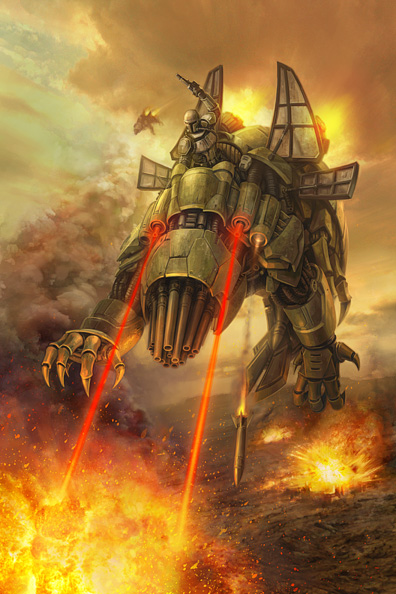
A Basilisk war droid and its rider in battle
The bodies of Basilisk droids were heavily armored and often colored in shades of green, though others were known to display hues of gray, or red with gold. Mandalorian riders, who controlled the beast-like droids from protective armored saddles atop the Basilisks, were known to garnish their mounts with an assortment of their personal weaponry strapped to the droid's body, including axes, swords, and flashpistols. The war droid's open combat models were, themselves, armed with a powerful array of artillery: pulse-wave cannons and auto-firing laser cannons, shatter-missile launchers, and concussion missile launchers with a four-missile payload could all be found on or under the armored plates of Basilisks. At the droid's nose resided the Basilisk's primary weapon, a cluster of shockwave generator rods that together could form a burst of plasma capable of ripping through the hulls of starships. Even the droid's heavy claws that adorned it's two front legs, used mostly as landing struts or for walking on the ground, could be used for brawling, crushing obstacles, or tearing open the body of an opponent. Basilisk droids often carried a pair of deployable space mines, and war droids of the combat type could tow volatile atomic compression bombs between them, catapulting the nuclear bomb into an enemy ship or space station. Mandalorian tinkering eventually spawned countless customized variants of the Basilisk, such as the two-seated bomber, which accommodated both a pilot and gunner, while the designated stealth configuration bore lighter armament and supplementary engines. Later models departed dramatically from the original droid's design, incorporating closed cockpits and larger S-foils, virtually eliminating the droid's animalistic appearance in favor of a form more similar to a starship.
Basilisk droids could operate effectively on the ground, in the air, or in the vacuum of space, and sensor clusters located at the fore and aft of the war droid allowed the Basilisk to detect threats from all directions. On the ground, Basilisk droids were typically slow and lumbering, but could move at faster speeds when required. In aerial combat, the Basilisk's rear armored wing plates—typically tucked against their bodies while at rest—would lift up to expose a set of high-boost engines that allowed the Basilisk droid to fly at speeds up to 550 kilometers per hour. However, while the war droid could reach great speeds, especially during bombing runs, it was slow to turn, weighted down by its heavy armor, and without the stabilizer fins at the tip of the droid's tail section, a Basilisk in flight was hard to control.
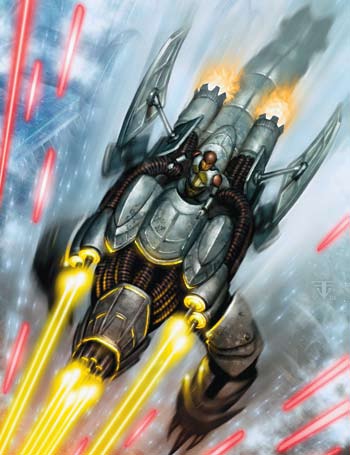
A Basilisk war droid flying into combat with weapons firing
With a level of intelligence slightly above that of typical domesticated creatures, the animal-like Basilisk droids formed strong empathetic bonds with their Mandalorian owners. These bonds allowed the droids to react almost preternaturally to the commands of their riders, and act as extensions of their own bodies. They were loyal companions, and were capable of serving as mechanical beasts of burden, carrying heavy equipment or towing large sleds laden with cargo.
In spite of their mechanical beast-like appearance and animal-level intelligence, a Basilisk acted more often as a gunship than a droid. Capable of operating in the vacuum of space—their Mandalorian riders dressed in pressurized suits of vacuum-sealed Mandalorian armor—Basilisk war droids were carried aboard Mandalorian warships, held in place by magnetic locks until being launched from drop bays, where they could participate in fleet engagements alongside other Mandalorian craft, even using their claws to latch onto opposing vessels. Pairs of war droids were able to coordinate the deployment of towed bombs against enemy starships or space stations. Basilisk droids could also enter a planet's atmosphere, and it was not uncommon for Mandalorian riders to direct their mounts in a surging dive directly from orbit to the planet's surface, using the rapid rate of descent to confuse the targeting computers of opposing ground cannons.
Within the atmosphere, Basilisk droids were used to conduct high-speed bombing runs, or provide strafing air support for ground troops while hovering. On the ground, the typically lumbering war droids were capable of significant bursts of speedy movement, and could use their heavy claws to batter or slice the body of a hostile.
The Basilisk war droids were first created by the Basiliskan race, a technologically minded reptilian people from the Core Worlds planet Basilisk, thousands of years prior to the rise of the Galactic Empire. In 4017 BBY, the Mandalorian Crusaders under the command of Mandalore the Indomitable launched an assault on Basilisk. The Basiliskans were overwhelmed by the Mandalorian Taung warriors, but rather than allow the invaders to claim their world, the arrogant Basiliskans poisoned their own planet in order to deny it to the Crusaders. Their actions succeeded in ensuring the Mandalorians abandoned the toxic world, but not before looting countless Basilisk war droids, along with numerous Basiliskan warships and Lagartoz War Dragons.
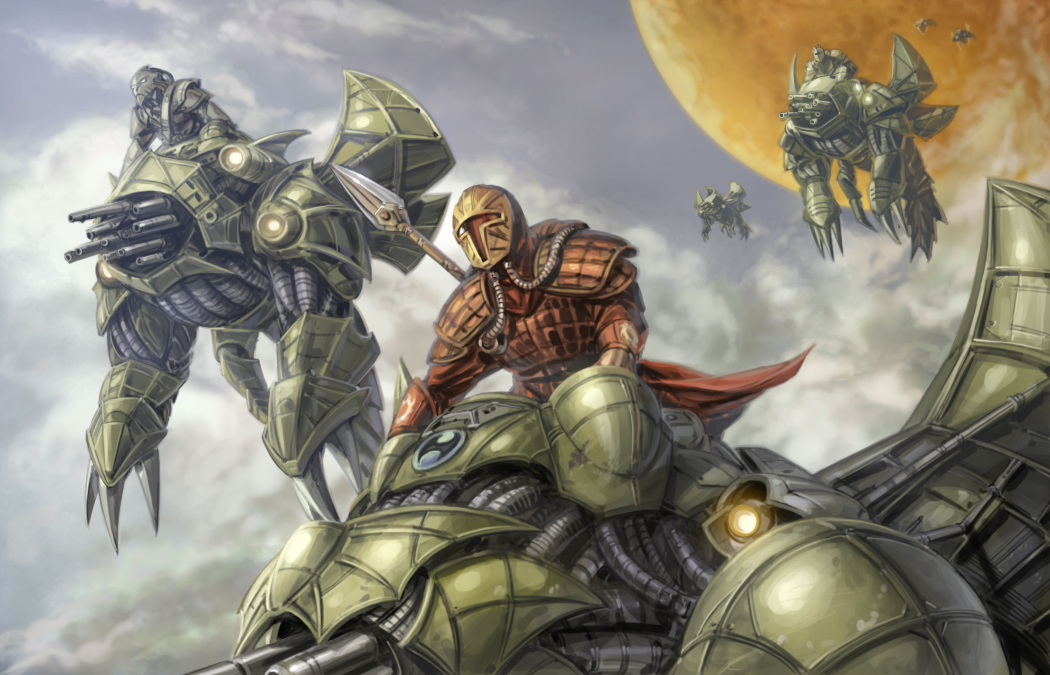
Mandalore the Indomitable leads his warriors into battle astride Basilisk war droids
Among the most unique weapons in the galaxy, the Basilisk war droid became a frequent sight among the forces of the Mandalorian Crusaders. Though the Mandalorians were traditionally ambivalent toward the use of droids, preferring the benefits of their own hard work, the Mandalorians came to view their acquired war mounts as close companions, forming strong empathetic bonds with their droids. Known in the Mandalorian language of Mando'a as bes'uliike, or "iron beasts," only the warriors of the highest standing in a clan were given the honor of piloting a Basilisk droid. The Mandalorians took to feeding their Basilisks a combination of locap plasma and unrefined Mandallian Narcolethe, and when a Basilisk droid fell in battle, it was given the funeral rites of a warrior before being sent to rest in the heart of a star.
With the Basilisk war droids under their command, the Mandalorian Crusaders conquered Kuar, and raided the borders of Krath space near the Empress Teta system. There, the Mandalorians came into conflict with the fallen Jedi Ulic Qel-Droma: Qel-Droma and Mandalore the Indomitable agreed to a challenge of single combat to take place on Kuar. Amidst the duel, Mandalore the Indomitable mounted his Basilisk war droid in combat against Qel-Droma, only to be defeated and forced on his honor to swear loyalty to the recently anointed Sith Lord. In service to Qel-Droma and his Sith Master, Exar Kun, the Mandalorians under Indomitable rode their Basilisk war droids into battle in an attack on Foerost that allowed them to claim the fleet of vessels being constructed at the planet's shipyards. Shortly thereafter, the Mandalorian Crusaders' Basilisk riders were part of the Qel-Droma's assault on the galactic capital world of Coruscant. Though the Mandalorians were ordered to retreat following the false declaration of Qel-Droma's death, they struck at Onderon atop their Basilisk droids, intent to conquer the world for Qel-Droma when they learned he had indeed survived. During the fighting at Onderon, however, a Galactic Republic frigate opened fire on Mandalore the Indomitable's war droid, leaving the Mandalorian leader to crash on Onderon's moon, Dxun, where he perished at the hands of the indigenous beasts. Upon finding the ceremonial Mask of Mandalore, Mandalore the Indomitable was replaced by a new warrior as the Mandalorian leader. Although the Great Sith War ended soon after, the new Mandalore had his own plans for the Mandalorians and their Basilisk droids.
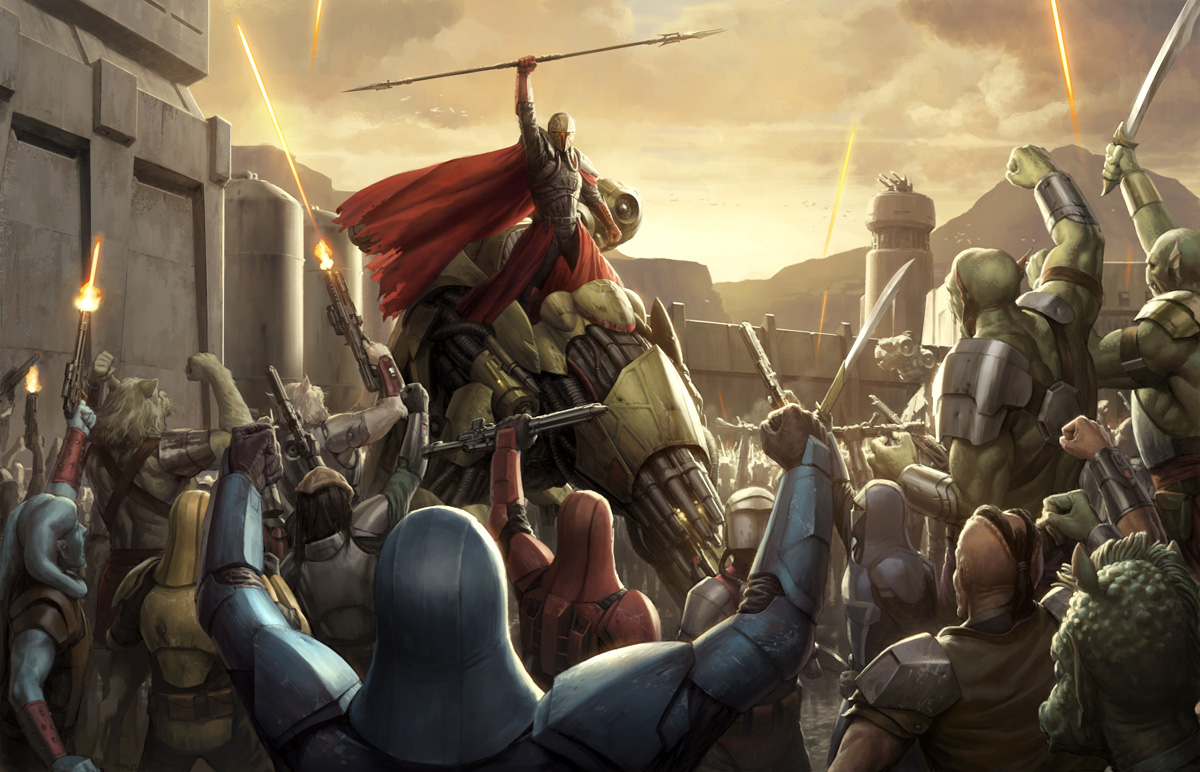
Mandalore the Ultimate rallies his Neo-Crusader troops from atop a Basilisk war droid
Mandalore the Ultimate set to challenge the Republic and conquer the known galaxy, inducting as many of its inhabitants as Mandalorians as possible with his army of Mandalorian Neo-Crusaders in what became known as the Mandalorian Wars. Mandalorian warriors astride Basilisk droid mounts assaulted Althir, and devastated Cathar, wiping out close to ninety percent of the Cathar populace, before moving on to conquer Flashpoint. At the battle at Vanquo, Basilisk droids took part in the orbital fighting, with at least one droid latching onto a Republic Aurek-class starfighter and tearing the canopy from the vessel with its front claws. By this point in time, the Mandalorians had established a number of Basilisk war droid variants, and a large number of the droids took part in the Mandalorian Siege of Taris, with several patrolling the skies of Taris during the Neo-Crusader occupation.
War droids fought alongside the Mandalorians again at Onderon and Dxun, while several Basilisks and their riders fell victim to the rakghoul outbreak on Jebble. At Essien, at least a dozen Basilisk droids were part of the Neo-Crusader forces intent on taking the planet. During the fighting, the war droid flown by Ko Sornell was shot down, though she and her son Gheedor were saved from Republic fire by the pacifistic Jedi Zayne Carrick. A squadron of Basilisk droids were carried aboard the Kandosii-type dreadnaught Parjai, headed for the planet Dantooine when the Mandalorian Knights targeted the Jedi Enclave there. At Duro, the Neo-Crusaders struck with numerous Basilisk droids, raining them down on the orbiting cities in a manner similar to meteors, and war droids fought under Cassus Fett at Jaga's Cluster.
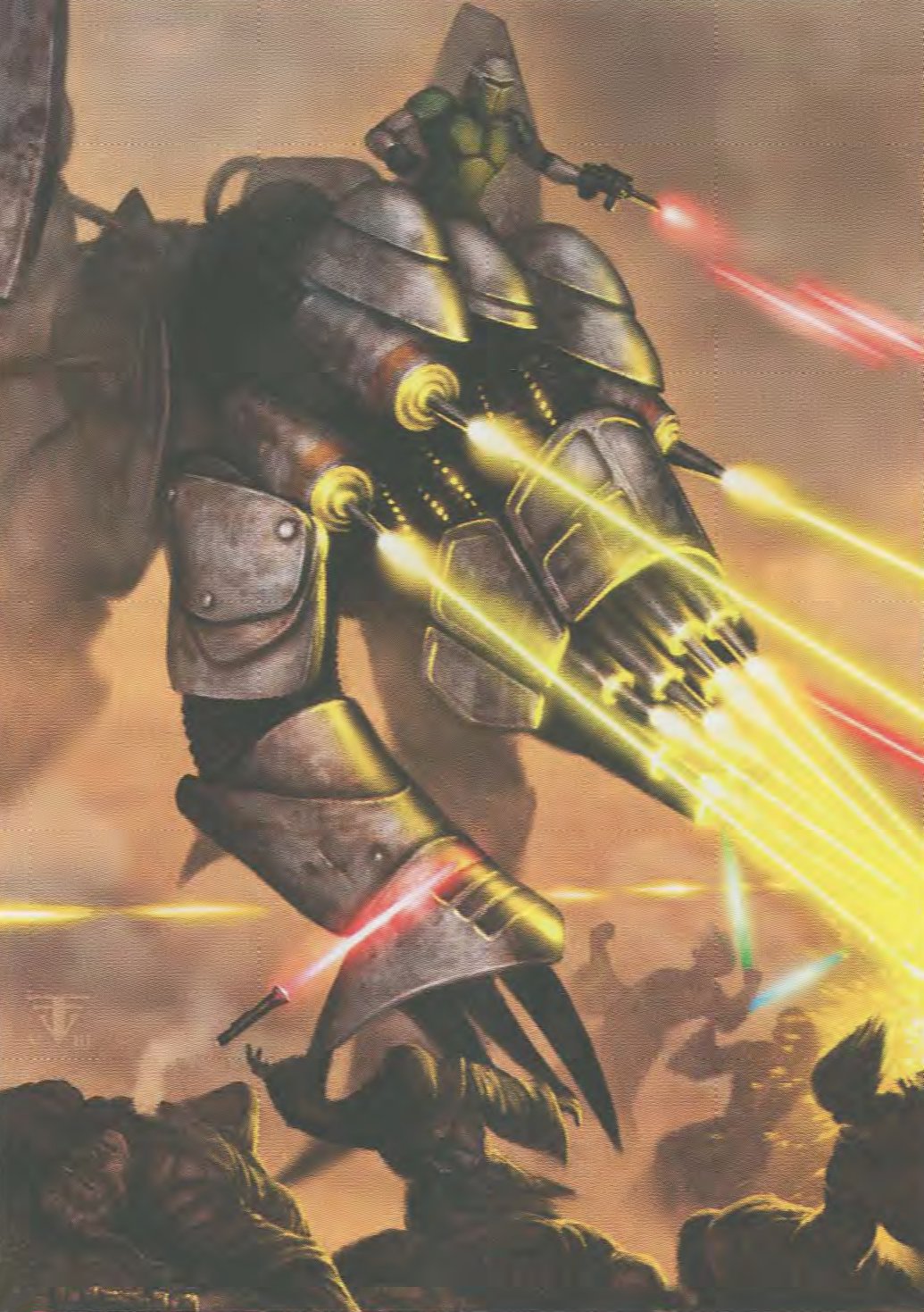
A Basilisk in flight, firing upon lightsaber-wielding foes on the ground
The Mandalorian Wars came to an end with the Battle of Malachor V, wherein Mandalore the Ultimate was killed in single combat by the Jedi Knight Revan, and the Mandalorians' fleet was devastated over Malachor V by the superweapon known as the Mass Shadow Generator. In victory, Revan commanded that the Mandalorians disarm, and even destroy their Basilisk droids. However, not all obeyed the terms Revan set down, and kept their war droids in secret; the Mandalorians of Clans Ordo and Jendri were two such groups who refused to give up their loyal mounts. While searching for Mandalore's Mask, taken and hidden by Revan following his defeat of Mandalore the Ultimate, several clans including Jendri and Ordo traveled to the Outer Rim world of Rekkiad, bringing their Basilisks with them. The Basilisk droids belonging to Clan Ordo assisted in transporting heavy cargo across the frozen, ice-covered surface of Rekkiad, before being forced into a skirmish with the Basilisk riders of Clan Jendri, when Ordo's members crossed into the territory Clan Jendri had established. However, Jendri possessed only four war droids in comparison to Ordo's six, and the battle turned in Clan Ordo's favor as the members of Clan Jendri retreated with their Basilisks. Clan Ordo succeeded in recovering Mandalore's Mask from Rekkiad, and Canderous Ordo went on to become Mandalore the Preserver.
As the new Mand'alor, the traditional leader of the Mandalorian clans, Canderous Ordo attempted to unite the Mandalorians that had scattered after the end of the Mandalorian Wars, assembling his clan and others at the Mandalorians' old outpost on the Onderon moon of Dxun. There, the Mandalorians who rallied to Ordo kept a modified Basilisk war droid, one with an enclosed cockpit and room to seat three Humanoid individuals.
When the Jedi Exile Meetra Surik traveled between Dxun and Onderon to intervene in the current civil war on the latter, she made use of Clan Ordo's Basilisk droid to reach the Onderon capital city of Iziz. Though several of its systems, including weapons, were off line, its armor and shields allowed it to come swooping sharply from the moon down to the planet's surface to evade the fire of the city's laser cannon defenses. The city locals feared the Basilisk's arrival, the memory of seeing the droid in action during the recent Mandalorian Wars still fresh in many of their minds.
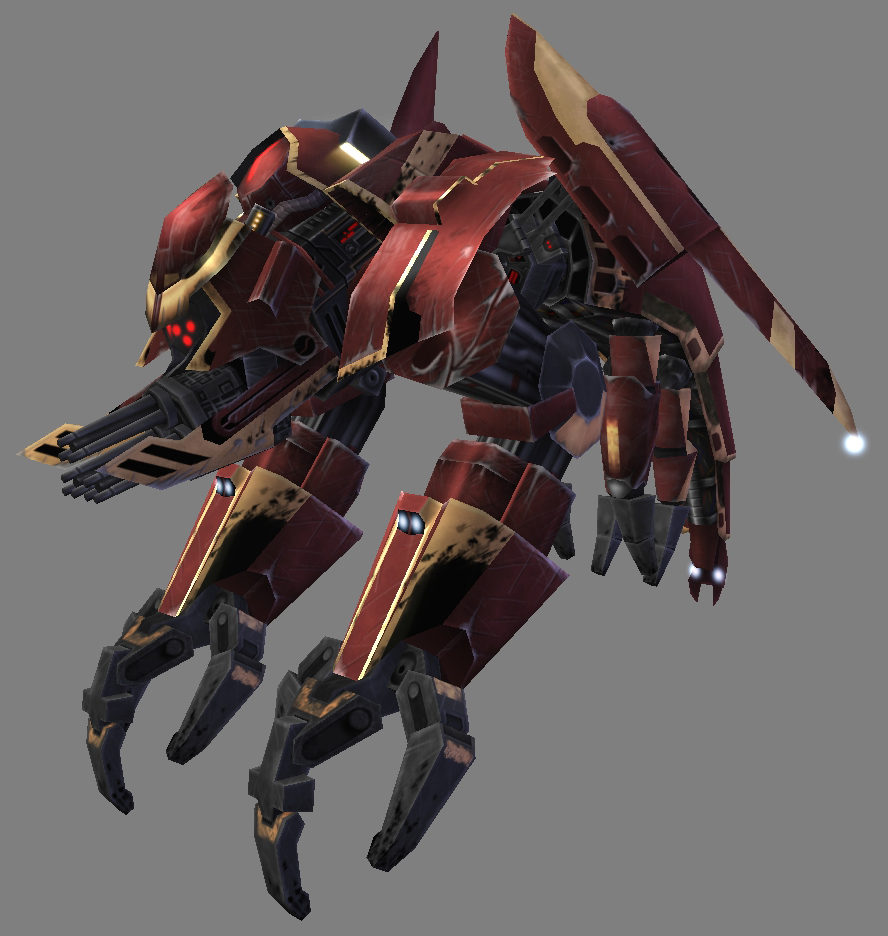
The Basilisk war droid owned by Chop'aa Notimo
By 2 BBY, Chop'aa Notimo had come into possession of a Basilisk war droid. That year, Notimo and his band of Mandalorian mercenaries took Corellian senator Garm Bel Iblis hostage on the planet Bespin. At the request of Jedi Knight Rahm Kota, the former Sith apprentice Galen Marek set out to rescue Corellia's senator from Bespin's capital, Cloud City, engaging Notimo's mercenaries before finally confronting the veteran Mandalorian soldier. Notimo called upon his Basilisk war droid to engage Marek, using the droid's heavy claws and laser cannon to keep the Force-wielder at bay. However, Marek was eventually able to violently throw the war droid into a wall, before ripping its mechanical body apart using the Force. Without his droid mount, Notimo attempted to fight Marek on his own but was defeated and killed, and Bel Iblis was rescued.
During the Galactic Civil War, engineers were able to acquire schematics for manufacturing recreations of the ancient Basilisk war droids. The droids the engineers designed were largely similar to the animalistic incarnation of the Basilisk, though they incorporated a pair of hind legs in addition to the long-standing front set, and could only carry one rider. During the early portion of the war between the Galactic Empire and the Alliance to Restore the Republic, these war droids were available for purchase to a number of spacers.
By the time of the New Republic, Basilisk war droids had become a rare sight in the galaxy. Most had been destroyed, and those that survived were largely deactivated, able to only be found behind the transparisteel display barriers of the galaxy's museums.
Despite the decline of the Basilisk's presence in the galaxy, the war droid remained a powerful symbol in the Mandalorian culture, and an icon of Mandalorian strength. When MandalMotors—a prominent Mandalorian starship company headquartered in the capital city of the planet Mandalore, Keldabe—began designing the StarViper-class attack platform around the time of the Battle of Yavin, many element of later Basilisk droid incarnations were evident in the new starfighter's conception.
Decades later, the engineers at MandalMotors created a new prototype starfighter known as the Kyr'galaar. However, upon the discovery of a new lode of nearly indestructible Mandalorian beskar iron on Mandalore, the company's CEO, Jir Yomaget, decided to incorporate the addition of beskar armor plating and rechristened the vessel as the Bes'uliik-class starfighter. A long-time admirer of the ancient Basilisk war droids, Yomaget felt the name appropriate for the highly advanced starfighter.
Basilisk war droids first appeared in the Star Wars universe in the first issue of the Tales of the Jedi story arc The Sith War, entitled Tales of the Jedi – The Sith War 1 and written by Kevin J. Anderson. The war droids continued to appear in subsequent issues throughout the story arc, and were given informational entries in The Essential Guide to Droids and it's later update.
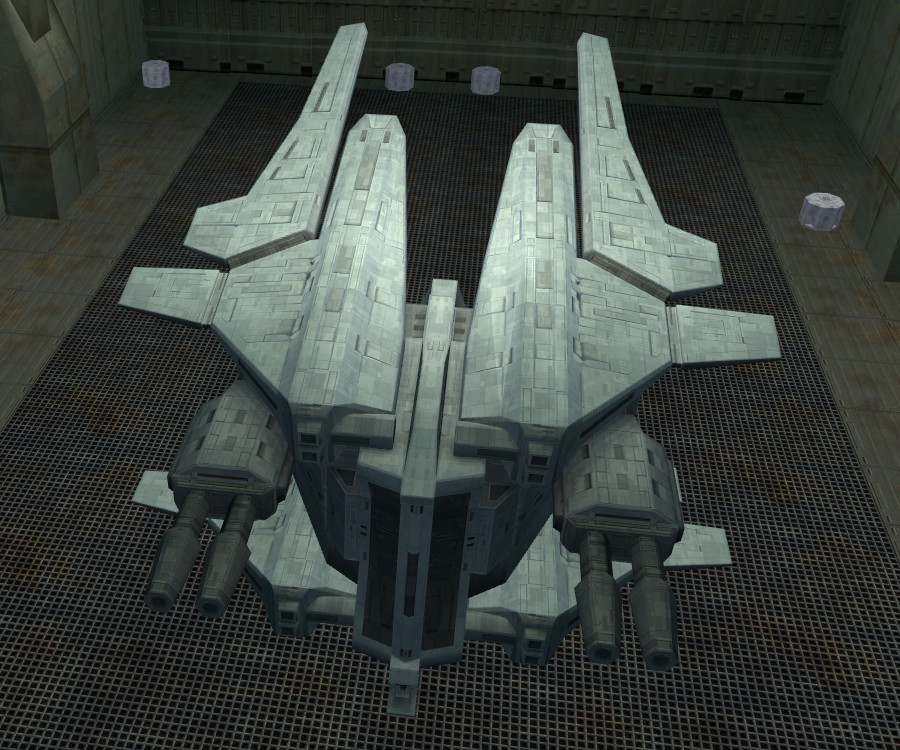
Canderous Ordo's divergent Basilisk war droid, similar in appearance to the StarViper, in Knights of the Old Republic II.
The first Star Wars: Knights of the Old Republic video game provides a detailed mention of the Basilisk war droids, before appearing in the sequel, Star Wars: Knights of the Old Republic II: The Sith Lords. However, there was a discrepancy between the Basilisk droid as described by the player's companion, Canderous Ordo in Knights of the Old Republic, and the appearance of the droid in the sequel. Ordo indicates that the vehicle is a small, open-aired mount, whereas Knights of the Old Republic II portrays a closed fighter, copying the design of Prince Xizor's Virago from Star Wars: Shadows of the Empire. This was a conscious decision by Chris Avellone and the second game's developers, who described the original animal-like appearance of the Basilisk droids as "really stupid", and attempted to replace the fantastical, "ancient" look of the comics with the more grounded look of the movies. However, both designs exist within the Star Wars Legends continuity, with references having subsequently been made to the older version; this difference may have been implicitly retconned as a difference between varying models of the war droid type.
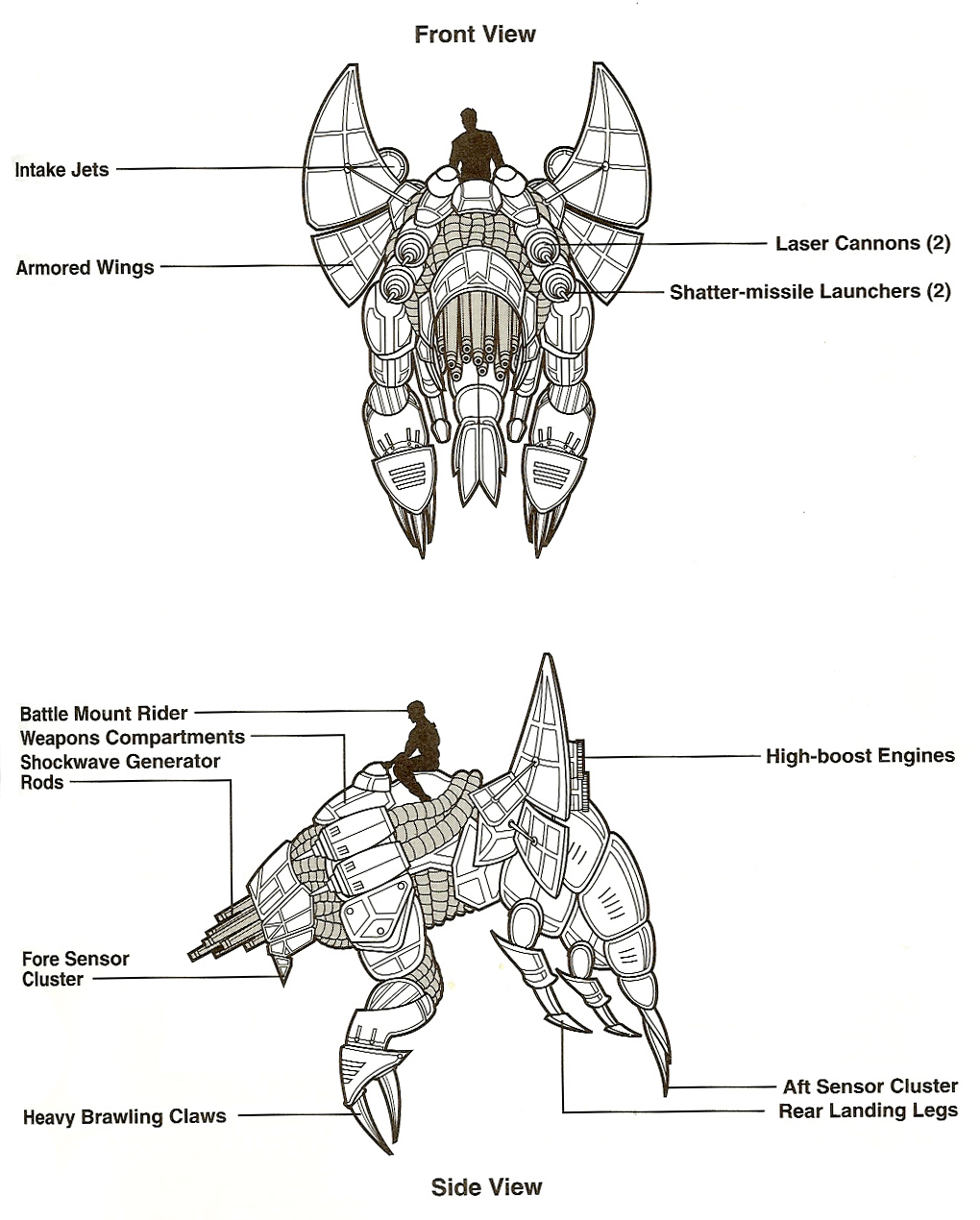
Basilisk schematics from The Essential Guide to Droids
Dustin Weaver, the artist for Star Wars: Knights of the Old Republic: Flashpoint seems to have made an effort to reconcile the design variations, depicting Basilisks with both the body of the traditional mount-type droid and the wings and details of the Virago-like design from Knights of the Old Republic II. Basilisk war droids made a number of appearances throughout the Knights of the Old Republic comic series, and into the subsequent mini-series, Star Wars: Knights of the Old Republic: War. Several Basilisk droids featured in Drew Karpyshyn's Star Wars: The Old Republic tie-in novel, The Old Republic: Revan, and the PlayStation 2, PlayStation Portable, and Wii versions of Star Wars: The Force Unleashed included a Basilisk war droid as part of a boss fight on Bespin. Two of Karen Traviss' Star Wars: Legacy of the Force novels, Legacy of the Force: Sacrifice and Legacy of the Force: Revelation, mention the Basilisk war droid, and Basilisk replicas can be found in the massively-multiplayer online game, Star Wars Galaxies.
Some ambiguity over the origins of the war droid's name have arisen since it first appeared. When introduced in the Tales of the Jedi comics, the Basilisk name was given with no explanation, and may have been a reference to the basilisk of real-world myth. Later, with the release of The History of the Mandalorians reference article in the eighty-sixth issue of Star Wars Insider, Abel G. Peña linked the Basilisk droids with the Basiliskan race of the planet Basilisk, implying that the Basilisk name was a descriptor based upon its creators. However, Karen Traviss, while developing the Mando'a language, created the Mandalorian word bes'uliik in reference to the war droids, a name which meant "iron beast". There is, as yet, no canonical explanation of the apparent homonymy of the name of the planet and the Mando'a term, though various solutions are possible.
Page 86 of The New Essential Guide to Droids states that the Mandalorians obtained the war droids from "the Basilikian homeworld."